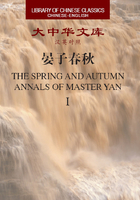
2.14 [39] (土)景公欲以圣王之居服而致诸侯晏子谏
齐景公打算用圣王的居室和服饰来招致诸侯,晏子进谏
【原文】
景公问晏子曰:“吾欲服圣王之服,居圣王之室,如此,则诸侯其至乎?”晏子对曰:“法其节俭则可,法其服(居其)室,无益也。三王不同服而王,非以服致诸侯也,诚于爱民,果于行善,天下怀其德而归其义,(若)〔善〕其衣服节俭而众悦也。夫冠足以修敬,不务其饰;衣足以掩形御寒,不务其美。衣不务于隅(肶)〔眦〕之削,冠无觚羸之理,身服不杂彩,首服不镂刻。且古者尝有紩衣挛领而王天下者,其义好生而恶杀,节上而羡下,天下不朝其服,而共归其义。古者尝有处橧巢窟穴而不恶,予而不取,天下不朝其室,而共归其仁。及三代作服,为益敬也,首服足以修敬,而不重也,身服足以行洁,而不害于动作。服之轻重便于身,用财之费顺于民。其不为橧巢者,以避风也;其不为〔窟〕穴者,以避湿也。是故明堂之制,下之润湿,不能及也;上之寒暑,不能入也。土事不文,木事不镂,示民(之)〔知〕节也。及其衰也,衣服之侈过足以敬,宫室之美过避润湿,用力甚多,用(则)〔财〕甚费,与民为雠。今君欲法圣王之服,不法其制,法其节俭也,则虽未成治,庶其有益也。今君穷台榭之高,极污池之深而不止,务于刻镂之巧,文章之观而不厌,则亦与民(而)〔为〕雠矣。若臣之虑,恐国之危,而公不平也。公乃愿致诸侯,不亦难乎!公之言过矣。”
【今译】
2.14 [39] DUKE JING WANTED TO EMULATE THE DWELLINGS AND CLOTHES OF THE SAGE-K INGS AND TO HAVE THE REGIONAL PRINCES COME AND PAY COURT TO HIM ON THAT BASIS. YANZI REMONSTRATED.
Duke Jing queried Yanzi as follow s: “I would like to be dressed like the sage-kings and live in houses similar in style to those they lived in. If I accomplish that,would I then bring other regional princes to pay court to me?”
Yanzi replied: “If you take as your model the frugality of the sagekings,then it w ill be possible to achieve this,but if your model is their clothing and houses,the endeavor w ill be useless. The Three Kings[1] wore different clothes and still they ruled like true kings. It was not on account of their clothing that they drew the regional princes to them. They were sincere in loving the people and resolute in doing good. The whole realm cherished their virtue and all were drawn to their righteousness and approved of their modest clothing,which delighted the multitude. As for caps,one should suffice w ith cultivating a respectful demeanor,rather than striving for decoration. Clothing should merely cover the body and ward off the cold,rather than striving for beauty. One’s dress should not strive for sharply cut angles and caps should not have a high and narrow shape.[2] The clothes on one’s body should not be multicolored,and there should be no carved adornments on one’s headgear. Moreover,in ancient times,some true kings of the realm used to have patched clothes and bent collars. Their righteousness lay in their love of life and their hatred of killing. They restricted superiors and aggrandize the inferiors; none of the residents made obeisance to them because of their clothing,but rather joined in being drawn to their righteousness. In ancient times,there were people[3] who did not detest to live in stick-made nests and caves; they gave and did not take; the whole realm made obeisance to them not on account of their housing,but rather of their humaneness. By the time of the Three Dynasties,official clothes were instituted to increase veneration; headgear was sufficient to inspire veneration,and was not heavy. The clothes on one’s body were sufficient to practice modesty,but did not hinder movement. The weight of clothes was com fortable for the body,and was affordable to the people. The reason people of that period no longer framed stick-made nests was in order to avoid the w ind,and the reason they no longer dug caves was to avoid dampness. Therefore,M ing Tang Hall’s[4] regulations ensured that no dampness could rise from below and neither cold nor heat could enter from above. Earthworks were not embellished and woodwork had no carvings,in order to show the people that they knew frugality. When these dynasties approached their downfall,the luxury of their clothing exceeded what sufficed for veneration,and the beauty of palaces exceeded what sufficed for avoiding dampness. The use of manpower was enormous,and the resources applied were costly,and so the Kings made the people into their enemies. But now you,my Lord,w ish to use as your criterion the clothes of the sage-kings,but not their regulations. If you take their frugality as a model,then even if you are unable to attain perfect order,it would probably be beneficial. But if you,my Lord,build the terraces as high as possible and ceaselessly dig ponds to a great depth; if you devote yourself insatiably to skillful carvings and to eye-catching emblems and ornaments,then you w ill transform the people into enemies as well. If my worries are realized,I am afraid that the state w ill be endangered and you yourself w ill not be safe. Would it not be a difficult matter,then,to w ish the regional princes to come to pay court to you? Your words were w rong!”
注释
[1]The Three Kings of antiquity,Yu 禹,Tang 汤 and Wu 武,the founders of the Xia,Shang and Zhou royal dynasties.
[2]羸→瀛 (YZCQ-ICS,15,n. 4).
[3]Yanzi’s statement is in reference to the former kings as in Liji,9.5/60/14: 昔者先王,未有宫室,冬则居营窟,夏则居橧巢 (“In the past the former kings had no houses; in the winter they lived in caves that they had dug,and in the summer they lived in stick-made nests.”).
[4]The M ing Tang 明堂—The Hall of Light—w as a unique royal structure of the state of Qi,mentioned in many texts that deal w ith rituals and sacrifices. Mencius considered the Hall of Light to be the hall of a true king (Mencius,2.5/9/24). For a detailed discussion of this hall,see James Legge; Ch’u Chai; Winberg Chai. Li Chi: Book of Rites. An encyclopedia of ancient ceremonial usages,religious creeds,and social institutions. New Hyde Park,N.Y.,University Books (1967): vol. 1,28-30. See also John S. M ajor,et al.,trs. The Huainanzi: A Guide to the Theory and Practice of Government in Early Han China. Translations from the Asian Classics. New York: Columbia University Press (2010): 882-883.